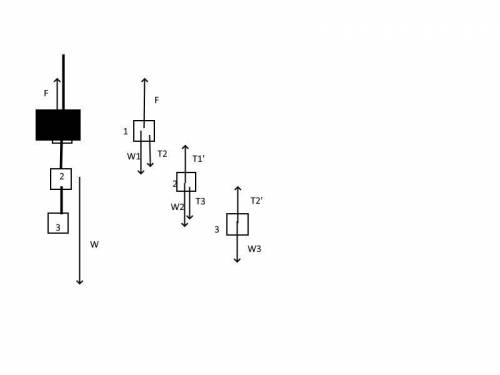
Physics, 28.02.2021 16:50 xandraeden32
A student suspends a chain consisting of three links, each of mass m 0.250 kg, from a light rope. The rope is attached to the top link of the chain, which does not swing. She pulls upward on the rope, so that the rope applies an upward force of 9.00 N to the chain.
a. Draw a free-body diagram for the entire chain, considered as a body, and one for each of the three links. (b) Use the diagrams of part (a) and Newton's laws to find (i) the acceleration of the chain, (ii) the force exerted by the
top link on the middle link, and (iii) the force exerted by the middle link on the bottom link. Treat the rope as massless.
1. There are four objects of interest in this problem: the chain as a whole and the three individual links. For each of these four objects, make a list of the external forces that act on it. Besides the force of gravity, your list should include only forces exerted by other objects that touch the object in question.
2. Some of the forces in your lists form actionâreaction pairs (one pair is the force of the top link on the middle link and the force of the middle link on the top link). Identify all such pairs.
3. Use your lists to help you draw a free-body diagram for each of the four objects. Choose the coordinate axes.
4. use your lists to decide how many unknowns there are in this problem. Which of these are target variables?
EXECUTE
5. Write a Newton's second law equation for each of the four objects, and write a Newton's third law equation for each actionâreaction pair. You should have at least as many equations as there are unknowns (see step 4). Do you?
6. Solve the equations for the target variables.
EVALUATE
7. You can check your results by substituting them back into the equations from step 6. This is especially important to do if you ended up with more equations in step 5 than you used in step 6.
8. Rank the force of the rope on the chain, the force of the top link on the middle link, and the force of the middle link on the bottom link in order from smallest to largest magnitude. Does this ranking make sense? Explain.
9. Repeat the problem for the case in which the upward force that the rope exerts on the chain is only 7.35 N. Is the ranking in step 8 the same? Does this make sense?

Answers: 1
Another question on Physics

Physics, 21.06.2019 22:00
Atank holds 1000 gallons of water, which drains from the bottom of the tank in half an hour. the values in the table show the volume v of water remaining in the tank (in gallons) after t minutes.t(min) 5 10 15 20 25 30v(gal) 694 444 250 111 28 0(a) if p is the point (15, 250) on the graph of v, find the slopes of the secant lines pq when q is the point on the graph with t = 5, 10, 20, 25, and 30.(b) estimate the slope of the tangent line at p by averaging the slopes of two secant lines.(c) use a graph of the function to estimate the slope of the tangent line at p. (this slope represents the rate at which the water is flowing from the tank after 15 minutes.)show all steps.
Answers: 2

Physics, 21.06.2019 22:30
Laboratory experiments, observational field studies, and model-building are all examples of different forms of scientific investigations. in what way do laboratory experiments primarily differ from other forms of scientific investigations? a. a laboratory experiment is the only accepted form of investigation within the scientific community. b. studies about how things behave in nature or studies involving very large objects are best answered through laboratory experiments. c. laboratory experiments involve the identification and control of variables. d. data can only be generated through laboratory experiments, not other forms of investigation.
Answers: 3

Physics, 22.06.2019 03:00
The respiratory system removes oxygen and water from the body. select the best answer from the choices provided t f
Answers: 2

Physics, 22.06.2019 05:40
Unpolarized light of intensity i_0=750w/m^2 is incident upon two polarizers. after passing through both polarizers the intensity is i_2=280w/m^2. (a) what is the intensity of the light after it passes through the first polarizer in w/m^2? (b) write an equation for the angle between the polarizers in terms of the initial (i_0) and final (i_2) intensities. (c) find the angle between the polarizers in degrees.
Answers: 3
You know the right answer?
A student suspends a chain consisting of three links, each of mass m 0.250 kg, from a light rope. Th...
Questions


Mathematics, 18.03.2021 20:20


Biology, 18.03.2021 20:20






Mathematics, 18.03.2021 20:20



Mathematics, 18.03.2021 20:20


Social Studies, 18.03.2021 20:20






 - g (1)
- g (1)



